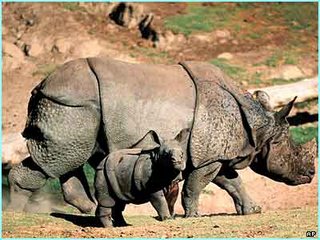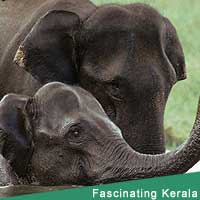All about Indian Rhinocerous
A few centuries ago, the Indian one horned Rhinocerous ranged across the north Indian plains in the wetlands of the rivers Indus, Ganga, and Brahmaputra. Today this survivor from the prehistoric times is found only in pockets in the north eastern state of Assam and in Nepal. In Assam, their Rhino habitat is limited to just two national parks - Kaziranga and Manas.
 Type of Rhinos
Type of RhinosThere are five kinds of Rhinos found in the world - white rhino, black rhino, Indian rhino, Javan rhino, and Sumatran rhino. The white and black Rhinos are live in Africa, while Indian, Javan and Sumatran are Asian Rhinos, found in Noth Pakistan, Assam in India, Nepal, Bhutan and Bangladesh.
The usual weight of an Indian Rhino is 2,000 kg. The one way to distinguish between a an Indian Rhino and an African Rhino is the single horn. Both white and black African Rhinos have two horns. Another distinguishing feature of the Indian Rhinoceros is its skin, which is knobbly and falls into deep folds at its joints, giving a look like the Rhino is wearing a coat of armour.
All the Rhinos are vegetarian and Indian Rhinos mostly eat grass, fruits, leaves and crops. Their well developed upper lip helps them to eat out tall elephant grasses, which they like the best. It also helps them to pull out aquatic plants by the roots. Indian Rhinos usually prefer to roam around in the morning and evening hours to avoid the heat of the day and live for about 40 years.
Kaziranga National Park
Lying along the mighty Brahmaputra river, the Kaziranaga National Park covers an area of about 430-sq-kms. Its swamps and grasslands with tall thickets of elephant grass and patches of ever green forest support the largest number of Rhino population in the whole of Indian subcontinent. Once reached to an alarming point due to hunting and poaching, this area came under wildlife conservation in 1926 and in 1940, Kaziranga was declared a sanctuary.
Wild Attractions of Kaziranga - Indian Rhino
The open county makes wildlife viewing at Kairanga fairly easy. A day's outing is often sufficient for visitors to see most of the major species here. Elephants take them into the park at the early morning hours. Other wildlife attractions at Kaziranga include Barasingha, Wild Buffalo, Wild elephants and Wild Boars. The grassland area is a raptor country and the crested Serpant Eagle and the Pallas Fishing Eagle and the grey-headed fishing Eagle can be seen circling over the marshes. The water-bird variety includes Swamp Parridges, Bar-headed Geese, Whistling Teal, the Bengal Florican, Storks, Herons and even Pelicans.
Manas National Park
Manas national park is another Rhino refuge and is noted for its population of the rare Golden Langur - found only this part of India. Other primates in Manas include the Capped Langur, Assamese Macaque, the slow Loris and the Hoolock Gibbon. Over 2, 840-sq-kms in area, Manas is a fascinating Tiger Reserve. The reserve is also home to the attractive Red Panda, but these are seen occasionally in the higher elevations. Manas is a very special biosphere, for it harbours twenty species of birds and animals that are highly endangered and listed in the IUCN Red Data Book. These include the Hispid Hare and the Pigmy Hog.
posted by Rishil Babu @ 1:14 PM,
,
![]()
Do you know Red Panda are found in India?
If anybody as a doubt about it... kindly take note of it!!! The Red Panda is a rare animal and because of its reclusive arboreal nature and the difficult terrain in which it lives, accurate estimates of the Red Panda population
 are hard to arrive at. It is estimated that there are about 2,500 Red Pandas left in the wild. Red Panda are basically called as "Fire Cat"is a tree dwelling mammal, which looks like a raccoon, with its bushy tail and white
are hard to arrive at. It is estimated that there are about 2,500 Red Pandas left in the wild. Red Panda are basically called as "Fire Cat"is a tree dwelling mammal, which looks like a raccoon, with its bushy tail and whiteand black markings across its face.
There are two species of Red Panda. One subspecies is found only in China, while the subspecies found in India is also found in parts of Southern China. In India Red Pandas are found in the sub Himalayan states of North East India - Sikkim, West Bengal and Arunachal Pradesh. The Red Panda weighs 3-6 Kg and is covered with red fur. It grows to a length of 50-60 cm with a 20-50 cm long tail. It looks like a raccoon, with white tipped ears, white markings on its face, long whiskers and a bushy striped tail. Its paws are equipped for grasping the stems of bamboo plants and twigs of trees. It has a strong jaw to help it chew bamboo and en extended pad on the sole of the forepaw and the first digit of its paw to help it grasp bamboo while eating and in climbing up trees.
The Red Panda, despite having a digestive system more suited to a carnivorous diet, subsists primarily on bamboo.Its diet also includes fruit, roots, acorns, lichen, grasses, and berries and Red Pandas are known to supplement their diet with young birds, eggs, small rodents, and insects on occasion.Captive Red Pandas readily eat meat.The loss of habitat as well as human population pressure on wildlife reserves in India is a matter of concern for Red Panda populations in India. The fragmentation of their habitat due to human encroachment, deforestation for agricultural reasons, firewood collection and logging for timber and the effect of domestic livestock species on the bamboo forests has led to the decline of Red Panda populations.
posted by Rishil Babu @ 4:13 AM,
,
![]()
 Chinnar Wildlife Sanctuary in South India
Chinnar Wildlife Sanctuary in South IndiaSprawled over an area of 90,422 sq kms at the Devikulam Taluk of Idukki district, Chinnar was declared a Wildlife Sanctuary in 1984. It is located in the rain shadow region of Western Ghats, thus witnessing only 48 rainy days annually. This is a unique thorny scrub forest with xerophyte species and is the habitat of the endangered Giant Grizzled Squirrel of India.
As one moves from Karimuthi to Chinnar, Elephants, Spotted Deers, Sambhar, tigers, gaurs, kraits, turtles, vipers, darters, black eagles, Hanuman Monkey and even Peacocks can be seen on either side of the Chinnar Wildlife Sanctuary. The undulated landscape with rock-strewn patches adds to the picturesque grandeur of the Sanctuary. The place is also ideal for boating and trekking.
Wet Grasslands, dry deciduous forests, high shoals are a common feature of this Sanctuary. Among the other species of flora include Acacia arabica (Karivelam), Acacia leucofolia (Velvelam), Santalum album (Chandanam), Anogeissuslatifolia (Mazhukanjiram), Elaeocarpus recurvatus (Bhadraksham) and Strobilanthus kunthianus (Neelakurinji).
The best times to visit the Sanctuary are almost throughout the year, except the months of October and November. Accommodations are easily available at a wide array of lodges, hotels and guesthouses that provide all kinds of comforts to those visiting the Chinnar Wildlife Sanctuary.
posted by Rishil Babu @ 8:10 AM,
,
![]()
 White Tigers in India
White Tigers in India Although white tigers are extremely beautiful animals, they serve no conservation purpose, with the exception of increasing attendance to zoos. Thus increasing public awareness and education of the plight of all endangered animals. For this reason, the SSP (Species Survival Plan) coordinators for the various surviving subspecies of tiger do not authorize breeding the white tiger in their managed programs. Still this remarkable animal continues to bring hundreds of thousands of fascinated visitors to zoos and educational facilities across the world. Public awareness is the first step in conservation.
Info: Tigers in general are the biggest cats in the world. They live in steamy hot jungles as well as icy cold forest habitats. There are five different kinds or subspecies of tiger alive in the world today.
These tigers are called Siberian, South China, Indochinese, Bengal, and Sumatran. Their Latin name is Panthera tigris. Tigers are an endangered species; only about 5,000 to 7,400 tigers are left in the wild. Three tiger subspecies, the Bali, Javan, and Caspian tigers have become extinct in the past 70 years.

Habits: Unlike some big cats like lions, adult tigers like to live alone (except for mother tigers with cubs). This is partly because in the forest, a single tiger can sneak up and surprise its prey better than a group of tigers can.
Diet: Over much of the tiger's broad geographic range, wild pig, wild cattle and several species of deer are its major prey. All prey are forest or grassland ungulates that range in size from 65 to 2,000 pounds (30-900 kg). Typically, wild tigers gorge themselves on fresh kills, and can eat as much as 40 pounds (18 kg) of meat at one time. The tiger will not eat again for several days.
Status: At the beginning of this century it is estimated that there were 100,000 wild tigers, today the number is less than 8,000. Simply put, tigers are disappearing in the wild. The main threats to tigers are poaching, habitat loss and population fragmentation.
posted by Rishil Babu @ 7:16 AM,
,
![]()
 The natural wealth of India subcontinent lies in hands of nature lovers.
The natural wealth of India subcontinent lies in hands of nature lovers.India always remains has one of the unique, mysterious and fascinating country with all their natural resources still demanded to be tapped and studied.
There are a host of ways of seeing India's wildlife but none can match that of walking and learning about the wondrous laws of nature and the daily struggle for survival in the wild
There are altogether 80 National Park and 441 Wildlife sanctuaries National park are famous for its Wildlife Population and its scenic beauty
Today! we can go into Saga ride with Royal White Bengal Tiger.
White tigers in the wild live to be about 10 to 15 years while tigers in zoos usually live between 16 and 20 years. They are usually found in the hardwood forest of India. Tigers are normally lonely animals and they are never in social groups like lions except when they are caring for their young. They usually keep their young with them for 2 or 3 years until the young tigers can stand for themselves.
Tigers usually stay in an area from about 10 to 30 square miles where there is enough prey, cover/shelter and water to support them. Territory actually depends on the amount of prey that is available. The more concentrated the prey the smaller an area a tiger needs to survive.
Things to be Remembered: Tigers do not hunt in social groups like lions. They are generally solitary animals. In the wild, tigers will eat pig, cattle and deer. They can eat as much as 40 pounds of meat at one time! After such a big meal a tiger will not eat again for several days. White Tigers have 30 large teeth ranging from 2.5 to 3 inches.
 Features of White Tiger: White tigers are born to Bengal tigers that carry an unusual gene needed for white coloring. The White Tiger is a good swimmer, but a very poor climber. They may be slow runners, but they are stealthy enough to catch any prey in their sights. Because they are solitary animals, they mostly hunt at night The other four sub-species of tiger are Siberian, South China, Indochinese, and Sumatran. There are only approximately 5,000 to 7,400 tigers left in the wild. It is belief that if you are born in the Chinese year of the tiger you are unusually lucky. Lets hope that some of this luck rubs off on the white tiger before it s too late.
Features of White Tiger: White tigers are born to Bengal tigers that carry an unusual gene needed for white coloring. The White Tiger is a good swimmer, but a very poor climber. They may be slow runners, but they are stealthy enough to catch any prey in their sights. Because they are solitary animals, they mostly hunt at night The other four sub-species of tiger are Siberian, South China, Indochinese, and Sumatran. There are only approximately 5,000 to 7,400 tigers left in the wild. It is belief that if you are born in the Chinese year of the tiger you are unusually lucky. Lets hope that some of this luck rubs off on the white tiger before it s too late.
At the beginning of this century it is estimated that there were 100,000 wild tigers, today the number is less than 8,000. Simply put, tigers are disappearing in the wild and the main threats to tigers are poaching, habitat loss and population fragmentation.
To wrap off, I have seen this amazing animal in the wild and would like to tell that it is the wonderful sight to watch the beautiful animal walking around the dense bushes with it unique colour of its skin which makes us thing that "if we cannot help this species then we have no right to kill it"... Especially for its beauty!!
posted by Rishil Babu @ 8:17 PM,
,
![]()